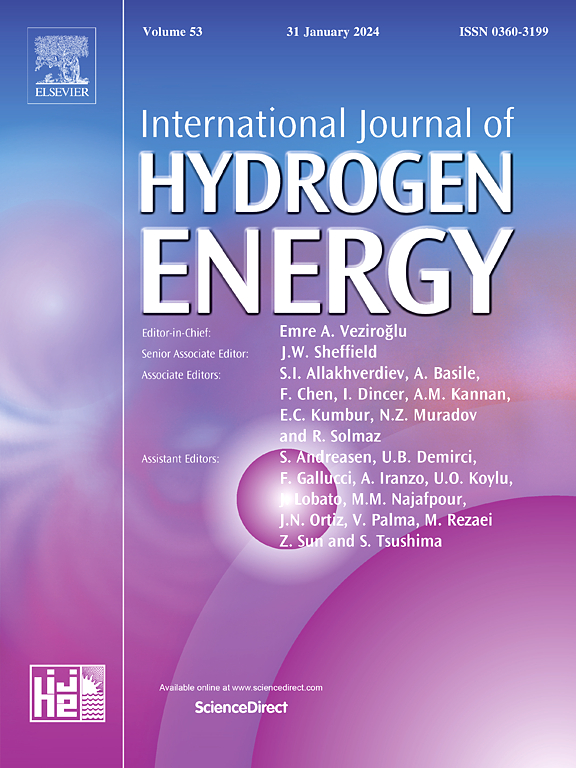利用bodipy -噻吩-共价有机聚合物驱动光催化制氢
IF 8.3
2区 工程技术
Q1 CHEMISTRY, PHYSICAL
引用次数: 0
摘要
硼-二吡啶(BODIPY)基染料作为光催化制氢的增敏剂近年来引起了人们的关注。由于其独特的性质,如高摩尔吸收率,可调节的吸收和发射能量,以及高荧光量子效率,它们通过高效的电子转移表现出高的催化活性。本研究考察了能提高亲水性的-OH亚基对bodipy -噻吩基共价有机聚合物(COP)光催化析氢反应的影响。在进行的研究中,将COP结构集成到BODIPY中以增强其光吸收能力,旨在作为简单条件下能量转换的光催化剂。在该体系中,噻吩- bodipy基染料被整合到COP结构中,在COP结构中,它们在光吸收时促进电子激发,从而通过促进电子转移在光催化反应中发挥有效作用。二氧化钛(TiO2)纳米粒子修饰的光催化剂,由于其光吸收能力、多功能荧光特性和电子接受特性,在提高制氢效率方面表现出显著的性能。合成的BODIPY-Th-COP-OH_TiO2光催化剂比BODIPY-Th-COP-CH3_TiO2表现出更高的氢活性,这是由于催化剂结构中羟基的存在促进了亲水性。因此,以甲醇为牺牲剂的BODIPY-Th-COP-X_TiO2光催化剂(X: OH, CH3)在可见光照射下,BODIPY-Th-COP-OH_TiO2光催化剂和BODIPY-Th-COP-CH3_TiO2光催化剂的氢量分别为0.197 mmol g−1 h−1和0.132 mmol g−1 h−1。本文章由计算机程序翻译,如有差异,请以英文原文为准。
Light driven photocatalytic hydrogen generation using BODIPY-thiophene-covalent organic polymers
Boron-dipyrromethene (BODIPY) - based dyes have recently garnered attention as sensitizers for photocatalytic hydrogen production. They exhibit high catalytic activity through efficient electron transfer, owing to their unique properties such as high molar absorptivity, adjustable absorption and emission energies, and high fluorescence quantum efficiencies. In this study, the effect of a –OH subunit that can increase hydrophilicity on the photocatalytic hydrogen evolution in BODIPY-thiophene-based covalent organic polymers (COP) was investigated. In the conducted research, COP structures were integrated into BODIPY to enhance their light absorption capabilities, aiming to serve as photocatalysts for energy conversions under simple conditions. In the proposed system, Thiophene-BODIPY-based dyes are integrated into COP structures, where they facilitate electron excitation upon light absorption, thereby playing an effective role in photocatalytic reactions by promoting electron transfer. The photocatalyst, modified with titanium dioxide (TiO2) nanoparticles, exhibited notable performance in enhancing the efficiency of the hydrogen production process, owing to its light absorption capabilities, multifunctional fluorescent properties, and electron-accepting characteristics. The synthesized BODIPY-Th-COP-OH_TiO2 photocatalyst demonstrated higher hydrogen activity compared to BODIPY-Th-COP-CH3_TiO2, attributed to the presence of hydroxyl groups promoted hydrophilic character in the catalyst structure. Therefore, BODIPY-Th-COP-X_TiO2 photocatalysts (X: OH, CH3) utilizing methanol as sacrificial agent yielded hydrogen amounts of 0.197 mmol g−1 h−1 and 0.132 mmol g−1 h−1 for BODIPY-Th-COP-OH_TiO2 and BODIPY-Th-COP-CH3_TiO2 photocatalysts, respectively, under visible light illumination.
求助全文
通过发布文献求助,成功后即可免费获取论文全文。
去求助
来源期刊

International Journal of Hydrogen Energy
工程技术-环境科学
CiteScore
13.50
自引率
25.00%
发文量
3502
审稿时长
60 days
期刊介绍:
The objective of the International Journal of Hydrogen Energy is to facilitate the exchange of new ideas, technological advancements, and research findings in the field of Hydrogen Energy among scientists and engineers worldwide. This journal showcases original research, both analytical and experimental, covering various aspects of Hydrogen Energy. These include production, storage, transmission, utilization, enabling technologies, environmental impact, economic considerations, and global perspectives on hydrogen and its carriers such as NH3, CH4, alcohols, etc.
The utilization aspect encompasses various methods such as thermochemical (combustion), photochemical, electrochemical (fuel cells), and nuclear conversion of hydrogen, hydrogen isotopes, and hydrogen carriers into thermal, mechanical, and electrical energies. The applications of these energies can be found in transportation (including aerospace), industrial, commercial, and residential sectors.
 求助内容:
求助内容: 应助结果提醒方式:
应助结果提醒方式:


